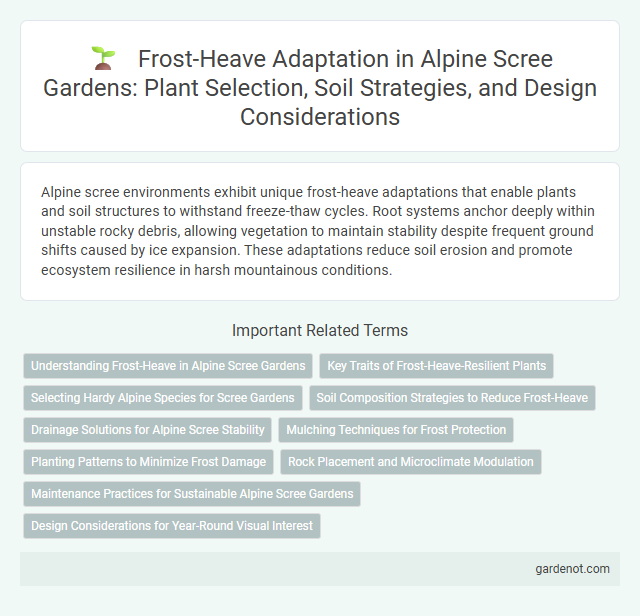Alpine scree environments exhibit unique frost-heave adaptations that enable plants and soil structures to withstand freeze-thaw cycles. Root systems anchor deeply within unstable rocky debris, allowing vegetation to maintain stability despite frequent ground shifts caused by ice expansion. These adaptations reduce soil erosion and promote ecosystem resilience in harsh mountainous conditions.
Understanding Frost-Heave in Alpine Scree Gardens
Frost-heave in alpine scree gardens occurs when freeze-thaw cycles cause soil and rock particles to expand and lift, disrupting root systems and plant stability. Adaptations such as deep taproots and flexible stems help alpine plants withstand the mechanical stress and nutrient redistribution caused by frost-heave. Monitoring soil temperature fluctuations and moisture content is crucial for understanding the intensity and impact of frost-heave on vegetation in scree environments.
Key Traits of Frost-Heave-Resilient Plants
Plants adapted to alpine scree environments exhibit key traits such as flexible root systems that withstand soil displacement caused by frost heaving. These frost-heave-resilient plants also display rapid root regeneration and tightly anchored root structures to maintain stability in shifting, frozen substrates. Additionally, cellular antifreeze compounds and dormancy mechanisms protect them from freeze-thaw cycles typical of high-altitude scree slopes.
Selecting Hardy Alpine Species for Scree Gardens
Hardy alpine species selected for scree gardens exhibit exceptional frost-heave adaptation through deep root systems that anchor plants in unstable, rocky soils. Species like Saxifraga oppositifolia and Silene acaulis survive seasonal freeze-thaw cycles by maintaining cellular antifreeze proteins and compact growth forms. Implementing these resilient plants enhances garden stability and biodiversity in alpine scree environments.
Soil Composition Strategies to Reduce Frost-Heave
Alpine scree environments adapt to frost-heave through specialized soil composition strategies that balance coarse rock fragments with fine mineral particles to improve drainage and reduce ice lens formation. Enhanced soil porosity and permeability in these substrates minimize water retention, limiting the expansion of frozen ground and mechanical soil displacement. This natural adjustment in soil texture plays a critical role in stabilizing the scree slopes against frost-induced upheaval.
Drainage Solutions for Alpine Scree Stability
Effective drainage solutions are critical for mitigating frost-heave in Alpine scree environments by preventing water accumulation and ice lens formation within soil layers. Permeable substrates and engineered drainage channels enable rapid water runoff, reducing soil saturation and minimizing frost-induced displacement. Stabilizing scree slopes through strategic water management enhances slope integrity, protects vegetation, and supports resilient alpine ecosystems.
Mulching Techniques for Frost Protection
Mulching techniques play a crucial role in frost-heave adaptation in alpine scree environments by insulating soil and reducing freeze-thaw cycles. Organic materials such as straw, leaf litter, or bark chips create a protective barrier that maintains soil temperature stability, preventing root exposure and soil displacement. Effective mulching enhances plant survival and soil structure integrity against the mechanical stresses caused by frost heave.
Planting Patterns to Minimize Frost Damage
Alpine scree environments exhibit distinct planting patterns where vegetation grows in clustered mats or spaced arrangements to reduce frost-heave damage. These spatial distributions enhance soil stability by insulating the ground and minimizing ice lens formation beneath roots. Such adaptive planting strategies enhance plant survival and soil retention in freeze-thaw dominated alpine landscapes.
Rock Placement and Microclimate Modulation
Alpine scree environments exhibit frost-heave adaptation through strategic rock placement, where loosely arranged stones create voids that buffer soil temperature fluctuations and facilitate water drainage. This microclimate modulation stabilizes the substrate by reducing ice lens formation and promoting root anchorage for specialized vegetation. The interplay of rock size, distribution, and thermal inertia slows freeze-thaw cycles, enhancing habitat resilience in high-altitude ecosystems.
Maintenance Practices for Sustainable Alpine Scree Gardens
Maintenance practices for sustainable alpine scree gardens emphasize managing frost-heave adaptation by ensuring proper soil drainage and minimizing soil disturbance. Using gravel mulch and selecting hardy, deep-rooted alpine plants help stabilize the scree substrate against freezing and thawing cycles. Regular monitoring of soil moisture and timely removal of debris reduce frost damage and promote long-term plant health in frost-prone environments.
Design Considerations for Year-Round Visual Interest
Alpine scree environments exhibit frost-heave adaptation through specialized plant root systems that anchor deeply and withstand soil upheaval caused by freeze-thaw cycles. Design considerations for year-round visual interest include selecting hardy alpine species with varied textures and seasonal color changes, ensuring continuous aesthetic appeal despite harsh environmental fluctuations. Incorporating layered planting with drought-tolerant groundcovers and resilient shrubs enhances stability while providing dynamic visual contrast throughout the year.
Frost-heave adaptation Infographic

 gardenot.com
gardenot.com